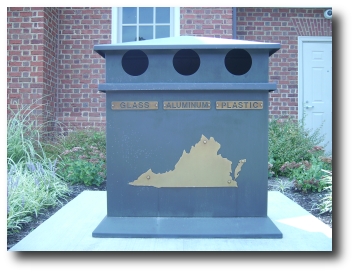I was driving on I-64 today, and had to make a pit stop at the rest area at mile marker 213. It is a new, architecturally-styled, rest area in brick, with a visitor center, new bathrooms and a bin for recycling. The bin had three different sub-bins: Plastic, Glass and Aluminum. All of this was encased in a very stylish brick block with an outline of the Commonwealth of Virginia in brass.
“What a great idea,” I thought as I dropped my Mountain Dew can in there. But I looked around me and there were two things wrong. First, there was no signage around the rest area letting anyone know that this mini recycling center was there. Second, it was on the downstream side of building and furthest away from the entryway to the restrooms. There were trashcans right at the entryway in the same dark brick design.
I looked for one of the workers at the rest area and found someone knowledgeable about trash: a young man with plastic bags stuck into his belt for easy access. He admitted that more recyclables go into the regular trash can than the recycling bins. I looked myself and saw about 7 aluminum cans and 6 plastic water bottles right on top of the two trashcans in front of the entryway.
I asked him where most people park and he said that they park upstream of the rest area before they get to it. I think most people do this for two simple reasons: first, they need to go to the bathroom and so just want to stop and go and secondly, if they pass the rest area building and there is no parking they may end up farther away.
Why isn’t the recycling bin near the entryway?

And my follow up question is “Why aren’t there other recycling bins at gas stations or at fast food joints?” It may be offensive to some but fast food places are known as “West Virginian Rest Areas.”
The Taco Bell my kids make me take them two at least once a week has a trash bin in the drive up line. Why can’t they have a recycling bin too? I know I clean out my car a little bit each time I get gas and it would be great to pitch a Gatorade plastic bottle into a recycling bin instead of having it rattle in my car until I get home and remember to get it out while carrying groceries, and stopping two kids from yelling at each other.
How much energy would be saved from this type of general painless recycling? There are 32 rest areas in Virginia. 47 in Texas and even 1 in Rhode Island. If I assume there are on average 32 in each state and 48 states; that’s 1,536 rest areas. And let’s say I’m being overly optimistic about how many rest areas are in each state, so let’s round that down to 1,000. When I asked my young rest area worker how long each trash can had been out there, he said about 2 hours.
Seven aluminum cans in two hours per rest stop does not sound like a lot, and let’s even say that because of traffic fluctuations that five is a more realistic number. That is still 60 cans in 24 hours per rest stop, or at least 60,000 cans per day across the country. That is a lot of potential energy to be saved. And a lot of mining that would not have to be done as well.






In Europe there is a wind energy revolution going on right now, with Germany leading the way.
Wind energy is destined to become the number one in renewables.